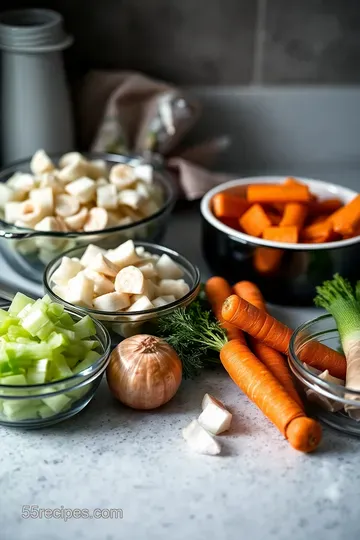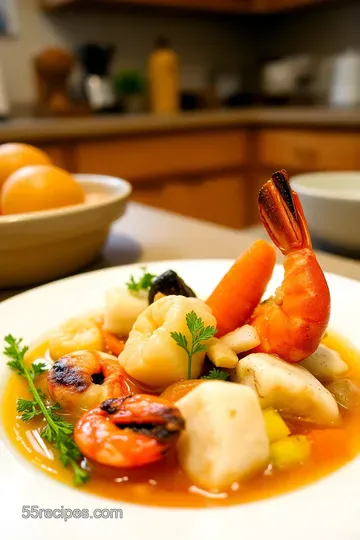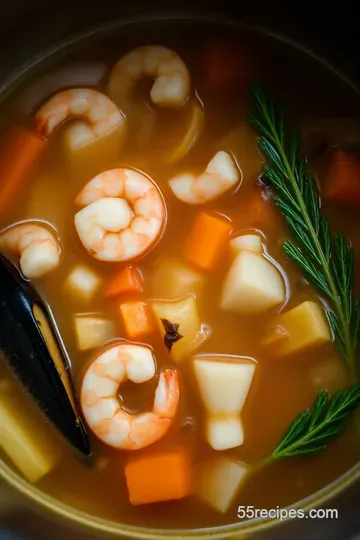Rich and Flavorful Seafood Stock
Master the art of making seafood stock with my easy recipe! Perfect for chowders and bisques, it’s your key to elevating seafood dishes at home.

look into into Flavor: The Ultimate Seafood Stock Recipe
Let me take you back to a sunny sunday afternoon. i was at my buddy jake’s place, and he just whipped up the most incredible seafood stock recipe that made my taste buds dance.
Just the smell of the aromatic vegetables simmering on the stove was enough to have us all gather around, imagining the delicious creations that would follow.
We were all talking about our favorite coastal dishes—like gumbo and shrimp bisque—when it hit me: the magic of a good stock can't be understated.
It’s the secret sauce, the flavor bomb that takes a dish from good to wow!
But here’s the kicker: making your own homemade stock isn’t just about enhancing flavor. it connects us to the wholeness of cooking.
That blend of fresh seafood ingredients and herbs makes you feel rooted in the culinary arts. how cool is that?
What’s the Deal with Seafood Stock?
Historically, stock making has been a staple in coastal cuisines all over the world. it’s how cooks have celebrated the ocean’s bounty for generations.
Nowadays, the interest in homemade stocks is popping off! you’ll find folks on tiktok sharing their nifty stock-making tips like they’ve discovered a hidden gem.
This isn’t just some background noise for a dish; it’s a powerhouse that enriches everything from italian paella to creamy seafood chowder .
Now, let’s talk about timing. cranking out this goodness takes about 1 hour— 15 minutes to prep and 45 minutes to let it simmer to perfection.
The beauty of this easy seafood recipe is that it’s medium in difficulty. you don’t need to be a culinary master to nail it, just a little patience and care will do.
And guess what? this recipe yields about 4 cups of stock that’s perfect for freezing. so, don’t sweat it if you're thinking how you’ll use all that flavor at once.
Why Seafood Stock Rocks
You might be wondering, “why should i invest my time in this?” well, let me spill the beans. first off, the nutritional value of seafood stock is top-notch.
Packed with minerals and nutrients, it boosts the flavor without loading you up on calories. just about 45 calories per serving, and you get that umami flavor perfect for crafting soups, stews, and even risottos!
There’s something special about whipping up this stock for special occasions, too. imagine a cozy gathering where your friends are digging into a bowl of homemade seafood bisque or shrimp risotto , all thanks to that seafood stock you spent an hour cooking.
Folks will be talking about dinner for weeks!
Plus, when it's made at home, you're in control. want a low-sodium seafood stock ? modify the salt to your liking.
Fancy a twist on flavors? add a little lemongrass or spices. it's like having your personal magic potion of flavor on hand.
You can also freeze the stock using ice cube trays, making it super convenient for those nights when you're craving something quick but still want that rich seafood broth taste.
Ready to Start Cooking?
So, are you ready to dive in and start creating your own rich and flavorful seafood stock ? this cornerstone of cooking is just waiting for you to give it a shot.
Trust me, once you've made your own stock, you’ll feel like a culinary wizard! now, let’s check out the ingredients you’ll need to get started.
..

Essential Ingredients Guide to Delicious Seafood Stock
When it comes to making a top-notch seafood stock recipe , knowing your ingredients can take your culinary game to a whole new level.
Let’s dive into the essentials you’ll want on hand, tips for freshness, and smart alternatives.
Premium Core Components
Detailed measurements:
to get it right every time, let's talk about measurements. in the u.s. system, you’ll want 1 lb (450 g) of shrimp shells and fish bones.
For our metric friends, that’s the same amount! for the vegetables, 1 medium onion , 1 large carrot , and 1 celery stalk are key players in creating that flavorful base.
Quality indicators:
pick out the freshest fish bones and shells. they should smell like the ocean—not fishy at all! fresh herbs should be bright and lively, like they just hopped off the farmer’s market truck.
Storage guidelines:
once you've made your homemade stock , you can store it in airtight containers—think glass jars or freezer bags.
It’ll last about three to four days in the fridge. if you're anything like me, batch cooking is the way to go! freeze some for later; it can keep up to three months .
Pro tip: freeze in ice cube trays! it's a game changer for those quick seafood recipes.
Freshness tips:
when selecting ingredients, keep an eye out for vibrant colors. if you're picking up veggies, aim for firm, unblemished specimens.
Think of how fresh ingredients affect everything from a seafood bisque recipe to a base for creamy chowder . fresh makes a world of difference!
Signature Seasoning Blend
Essential spice combinations:
get ready to flavor up! whole black peppercorns, bay leaves, and fresh thyme are pretty much a must for that umami depth in your stock.
Feel free to toss in other herbs that strike your fancy!
Herb selections and pairings:
don’t shy away from falling in love with fresh herbs. they can elevate a simple fish stock recipe into something that dances on your palate.
Dill, tarragon, or even a kick of parsley can be real game changers.
Flavor enhancers:
here's where it gets fun! a splash of dry white wine can uplift your stock like none other.
If you want the flavor without the buzz, lemon juice can add that zing without any alcohol involved.
Regional Variations:
Depending on where you're at, your stock can take on a different flair. Want something more coastal? Think about adding some seaweed or mussel shells for an ocean kiss!
Smart Substitutions
Common Alternatives:
Don't sweat if you can't find something! Need a replacement for fish bones? Try leftover bones from a filleted fish. A little improvisation can lead to delightful inventions.
Dietary Modifications:
For a low-sodium seafood stock, simply cut back on added salt. It’s perfect for making dishes that you can control the health aspect of without sacrificing flavor.
Emergency Replacements:
Running low on one ingredient? Use onion powder and carrot juice to fill in the gaps. Trust me; it totally works in a pinch!
Seasonal options:
don’t forget to let the seasons guide you. if you find yourself in the midst of summer, adding fresh tomatoes or corn can add sweetness and brightness to your stock.
Kitchen Equipment Essentials
Must-have tools:
grab that large stockpot, fine mesh strainer, and a trusty ladle. these are your golden trio for crafting the best stock.
If you don’t have a fine mesh strainer, a cheesecloth will do the trick!
Alternative Equipment Options:
If you’re tight on space, you can always use whatever pots you have on hand. Just ensure they’re big enough to hold all that deliciousness.
Preparation Tips:
Before you even start, get all your ingredients chopped and ready. A little prep helps keep the chaos to a minimum!
Storage solutions:
label your stocks and freeze them. this way, you won't end up wondering what’s what when you’re neck-deep in a seafood chowder recipe.
Remember, those freezer bags can be a lifesaver!
And there you have it! armed with these essential ingredients and tips, you’re all set to create a rich and flavorful seafood stock that can take your dishes from good to wow! the next section will guide you through the step-by-step process to make this liquid gold.
Happy cooking, my friend!

Unlocking the Flavors: Mastering Professional Cooking with Seafood Stock
If you’ve wandered into the world of cooking with seafood , you know how rich and delicious a good seafood broth recipe can be.
It’s pure gold when it comes to building the foundation for a cozy bisque or a hearty chowder. i remember the first time i tried making my own homemade stock—it was a game changer! let’s delve into how to create a rich and flavorful seafood stock that’ll have your taste buds dancing like it's a summer beach party.
Essential Preparation Steps
First things first! if you want to nail your seafood stock recipe , you're gonna want to start with some essential prep step.
Let’s chat about mise en place —it’s just a fancy way of saying “everything in its place.” gather all your ingredients before starting.
Pro Tip: Chop your aromatic vegetables —we’re talking onions, carrots, and celery—before you turn on the stove. This way, you're not running around like a headless chicken while trying to multitask!
Next is time management and organization. seriously, time can slip away when you’re having fun in the kitchen. if you plan to simmer this dreamy stock for about 30- 40 minutes , use that time wisely.
Maybe prep some fresh herbs while it cooks, or put on a favorite playlist. yep, that’s right! throw in some old-school rock, and you’ll be cooking like a pro in no time.
Don't forget about safety, either! Always handle seafood carefully, and wash your hands after touching raw ingredients. You don’t want to be the star of a food-poisoning horror story, right?
Step-by-Step Process to Seafood Bliss
Alright, let’s tackle this step-by-step:
-
Sauté the Seafood: Grab that large stockpot. Get those shrimp shells sizzling for 2- 3 minutes until they smell heavenly.
-
Add Veggies: Toss in your onion, carrot, celery, and smashed garlic. Sauté for about 5 minutes until softened.
-
Pour in wine: if you’re feeling fancy, add 1 cup of dry white wine . let it cook for about 2 minutes and scrape up any delicious bits stuck to the bottom.
-
Mix it all up: Add 10 cups of cold water , your bay leaf, thyme, and peppercorns. Bring it to a gentle simmer.
-
Simmer Time: Let that baby simmer for those glorious 30- 40 minutes . Keep skimming any foam that pops up like unwanted guests at a party!
-
Strain for Perfection: After simmering, strain it through a fine-mesh strainer, discarding those solids.
-
Cool and Store: Let it cool completely before storing in airtight containers. Oh, and it freezes well too! Portion it out in ice cube trays for quick and easy stock future meals.
Expert Techniques for Quality
Here’s where we dive into chef tips for stock . it’s all about quality assurance. to ensure maximum flavor, always use fresh seafood ingredients.
Nothing beats the taste of freshly caught shrimp or fish. plus, don’t overcook it—if you boil your stock, it'll get cloudy.
We want that crystal-clear goodness, trust me.
Quick note: Stock can be a versatile foundation. Think about using it for a risotto or a paella base —so many options to twirl with flavors!
Success Strategies for the Win
Let’s chat about those common mistakes. i used to think more ingredients meant better flavor. but no, no, no! quality trumps quantity every time.
Also, make sure to cool your stock properly. it should not sit out for more than two hours at room temperature.
Remember, safety first!
Freezing is a great option. Just store your stock in ice cube trays for easy use later. I mean, who doesn’t love having homemade stock on demand?
Wrapping It Up
Culinary adventures can be dreamy and messy. But making homemade seafood stock doesn’t have to be intimidating. You’ll find that cooking time for stock is just a small part of the joy of creating something from scratch! And when you take that first sip of your rich, gorgeous seafood stock, you’ll know—oh my gosh, it was totally worth it!
So, are you ready to become a stock-making superstar? Grab your fresh seafood ingredients , channel your inner chef, and let’s get busy in the kitchen crafting that magnificent seafood stock !
Stay tuned for some additional information on making even more delicious recipes!

look into Into Seafood Stock: The Secret to Flavor Town
Hey there, friends! let’s talk about one of the most underrated gems of cooking— homemade seafood stock . seriously, if you’re not already whipping up your own, what are you waiting for? this isn’t just any simple seafood broth recipe ; it’s a total game-changer for dishes like seafood chowder or a rich seafood bisque recipe.
You know that moment when you taste something and think, “wow, this has so much flavor!”? yeah, that’s the magic of great stock.
Pro Tips to Level Up Your Seafood Stock
Now, before diving into the nitty-gritty, let me share my two cents. when making this fish stock recipe , pay attention to your ingredients.
Always try to use fresh seafood, and if you have extra shrimp shells lying around, guess what? you can toss them in.
Chef tip? sauté those shrimp shells to release their aroma. it’s like the best welcome mat for flavor!
And let’s talk time-saving hacks! ever think about having stock ready to go? i like filling ice cube trays with my rich seafood stock after it cools.
Pop those cubes in the freezer, and voilà! you've got instant flavor boosters for quick seafood recipes on busy nights.
Perfect Presentation: Make It Eye-Catching
Okay, let’s take your presentation up a notch. once you’ve got your stock going, remember, the first bite is with the eyes! for a nice touch, ladle your stock into a clear bowl, and garnish with fresh herbs like parsley or chive snips.
A splash of lemon juice gives that bright pop!
And colors? Think coastal cuisine! Use vibrant red peppers or green onions for pops of color. Serve alongside a nice crusty baguette, and you've got the perfect Instagram moment right there, my friend!
Storing & Making Ahead
So, you made a big pot of deliciousness but aren’t going to use it all at once? no problem! storage methods are key here.
Ensure your stock is cool before you stash it in the fridge. i stick to clear containers—this way, i can see what i’ve got.
Generally, you can keep it fresh for about 3-4 days . but if you want longer, freeze it!
When reheating, low and slow is the way to go. pour the stock into a saucepan over medium heat until it's warmed through.
No high heat here! we don’t want that flavor to go bye-bye.
Get Creative: Variations to Keep It Fresh
Now, if you're feeling adventurous, don’t hesitate to switch things up with recipe variations . why not try adding seaweed to your seafood stock? it amps up that umami flavor we crave.
Or maybe toss in some aromatic vegetables like fennel for an unexpected twist. if you’re on a no-meat kick, just include more veggies—your stock will still be fabulous!
And when seasonal ingredients pop up? use them! fresh herbs in springtime or roasted corn in the summer can elevate your stock’s flavor.
It’s all about being flexible and having fun with flavors.
Speaking of flavors, each cup of this stock packs a nutritional punch. the nutritional value of seafood stock is impressive, bringing in a nice amount of protein and those tasty omega-3s.
This makes it not just a delicious addition but a health-conscious one too.
Wrapping It Up: Go Make This Seafood Stock
So, fellow foodies, embrace the power of seeking out fresh seafood ingredients and making your own stock. whether you’re a newbie or a seasoned pro, this homemade seafood stock is a key player in your kitchen.
It’s a healthy, flavorful base for so many meals. plus, nothing feels quite as rewarding as saying, “oh yeah, i made that!” when you serve up a seafood risotto or a fancy paella base.
So, what are you waiting for? grab those shrimp shells and some fish bones, and get cooking! you’ll thank yourself later—trust me.
Your next culinary masterpiece is just a batch of seafood stock away! happy cooking!
Frequently Asked Questions
What is a seafood stock recipe and why is it important?
A seafood stock recipe is a flavorful base made from simmering seafood scraps like shrimp shells and fish bones with aromatic vegetables and herbs. It’s essential for dishes like chowder and bisque, as it adds depth and complexity to your meals, elevating a simple soup to something truly special!
Can I use frozen seafood shells for this seafood stock recipe?
Absolutely! Frozen shrimp shells and fish bones work just as well as fresh ones. Just make sure to thaw them before you start the recipe—this will help you achieve a rich, flavour-packed stock without any hassle!
How long can I store homemade seafood stock?
Homemade seafood stock can be stored in airtight containers in the fridge for about 3-4 days. For long-term storage, consider freezing it! An easy way is to pour the stock into ice cube trays, which you can pop out as needed for future recipes.
What are some variations I can try with my seafood stock?
Feel free to get creative! You could add some seaweed like kombu for extra umami, or incorporate herbs like dill or tarragon for a fragrant twist. If you've got leftover bones from a fillet, they can easily replace fresh fish bones in your stock!
Is seafood stock healthy?
Yes, seafood stock is quite healthy! It's low in calories and packed with protein and minerals, making it a nutritious choice for soups and sauces without the added fat. It’s also a great way to use up scraps, reducing food waste while boosting your dishes’ flavour!
Can I use this seafood stock for dishes other than soups?
Definitely! Your homemade seafood stock can enhance a variety of dishes, from risottos to paellas or even as a cooking liquid for grains like quinoa or couscous. It’s a versatile ingredient that can bring a splash of seaside goodness to almost any meal!
Rich and Flavorful Seafood Stock Card

⚖️ Ingredients:
- 1 lb (450 g) shrimp shells (from 1 lb shrimp)
- 1 lb (450 g) fish bones (white fish like cod or snapper)
- 1 medium onion, roughly chopped
- 1 large carrot, roughly chopped
- 1 celery stalk, roughly chopped
- 2 cloves garlic, smashed
- 1 bay leaf
- 5-6 sprigs fresh thyme
- 5-6 black peppercorns
- 10 cups (2.4 L) cold water
- 1 cup (240 ml) dry white wine (optional)
🥄 Instructions:
- Step 1: Collect all the ingredients and chop the vegetables.
- Step 2: In a large stockpot, add shrimp shells and sauté for 2-3 minutes until fragrant.
- Step 3: Add the onion, carrot, celery, and garlic; sauté until slightly softened, about 5 minutes.
- Step 4: Pour in the white wine (if using) and cook for 2 minutes; scrape any browned bits from the bottom of the pot.
- Step 5: Add cold water, bay leaf, thyme, and peppercorns; bring to a simmer.
- Step 6: Reduce heat and let it simmer gently for 30-40 minutes, skimming any foam that rises to the surface.
- Step 7: Remove from heat; let cool slightly, then strain the stock through a fine mesh strainer or cheesecloth into another pot, discarding solids.
- Step 8: Cool the stock completely before storing in airtight containers or using immediately.
Previous Recipe: Toasted Coconut Marshmallows: A Sweet Escape to Tropical Delights
Next Recipe: Comforting Bone Broth Hot Chocolate Recipe: A Guilt-Free Indulgence
